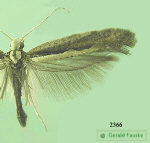Family Plutellidae: Diamond-backed moths
| Diagnosis: Ocelli present, proboscis unscaled; fw
with Rs4 running to outer margin; fw
inner margin usually with a longitudinal band of pale (brown to
silvery-white) scales. A moth with closed wings when viewed from above
has the silvery ‘diamond back.’
Diversity: Fewer than 100 species worldwide; 20 species in eight genera in North America; as yet a single species known from North Dakota. Checklist numbers: 2347- 2366. Biology: Larvae are communal web makers on Brassicaceae– mustards. Boldly patterned pupae are visible inside a loose meshed cocoon.
|
|
| Further reading:
Dougdale, John S. et al., Chapter 8. The Yponomeutoidea, pp. 119- 130 in Kristensen, Neils P. ed. 1999. Lepidoptera, moths and butterflies. Part 35, Vol. 1 in Handbook of Zoology. Maximilian Fischer ed. Walter de Gryter, New York. 491 pp. Scoble, Malcom J. 1992. Chapter 11. Lower Ditrysia, pp. 225- 254 in The Lepidoptera: form, function, and diversity. Oxford Univ. press. 1982. 404 pp. Talekar, N. S. and A. M. Shelton. 1993. Biology, ecology, and management of the diamondback moth. Ann. Rev. Entomol. 38: 275- 301.
|
|
